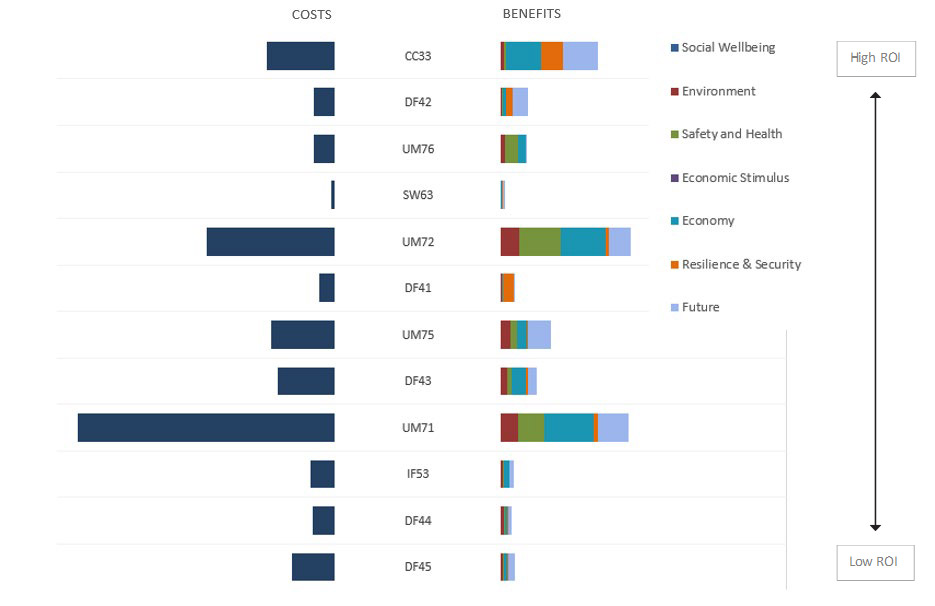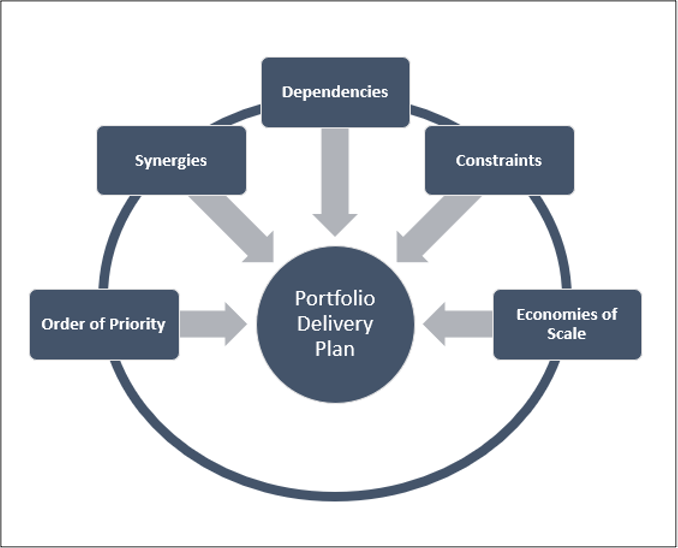This is Part 4 of a 6-part series. In this Insight, we cover the MoP Portfolio Definition process steps, Balance and Plan, through the lens of Decision Science.
Balance using MCDA Analysis
Analysis of the MCDA model creates a deeper understanding of how the Initiatives contribute to the portfolio. The ‘Tornado’ chart below is one representation of the relative contribution each Initiative offers based on how it performs against the benefit, risk and cost criteria. The Initiatives are ordered from the highest benefit/cost ratio at the top to the lowest at the bottom.

Another powerful portfolio view is the ‘efficiency frontier’, as shown below for an example model. The leading edge of this curve shows the maximum relative benefit that can be achieved for a given cost. The individual Initiatives are represented by the dots and triangles on this curve, ordered by decreasing benefit/cost ratio from left to right. Different portfolios (selections of Initiatives) can be shown on this chart to illustrate how close they are to the efficiency frontier.

The current portfolio or investment plan (shown above as ‘Status Quo’) is almost always sub-optimal. The theoretically ‘Optimal’ portfolio is on the frontier for a given level of investment. However, there are many reasons (financial constraints, organisational capacity, dependencies, timing) why an organisation might not choose this combination. The example above has a portfolio with a ‘Short-Term Focus’, accepting a slight loss of efficiency for that particular emphasis, and a ‘10% Cost Saving’ option.
MCDA modelling and Decision Conferencing do not make decisions, the responsible decision maker or body does. However, the MCDA Model and a Decision Conference do provide a requisite process to enable a healthy discussion of alternatives, which can then support a decision. Analysis also allows decision makers to see what the recommended portfolio looks like through different lenses. This allows any rebalancing conversations to be informed by the benefits, risks and costs and the trade-offs involved.
To create a portfolio option (a portfolio that could be approved) for decision-makers we recommend the following approach. Start from the best value for money initiative and add additional Initiatives based on the order of priority from the Decision Conference until the constraint identified for the organisation is achieved (there may be more than one to consider). Review the portfolio through the lenses of the different balancing considerations and planning considerations (see Figure 2) to see if the proposed portfolio option will work.
Balancing in MoP terms seeks to ensure that a portfolio option makes sense when the following factors are considered:
- Coverage of the organisation’s strategic objectives, to the extent they are affordable and achievable
- The mix of levels of risk vs. return
- The stage of initiatives in their delivery lifecycle
- Timing of initiatives – to avoid unsustainable burden on specific parts of the organisation
- Change impacts across the business (e.g., by geographic area and function)
The boundary between the balance and planning stages can be blurred in that many of the considerations in getting a balanced portfolio (above) are also considerations in planning (Figure 3). We think about the main emphasis of balancing being about getting to the point where the portfolio option looks like it can work and makes sense in terms of the value it delivers and the other considerations above.
Plan to deliver

Following a Decision Conference any organisation needs to turn the analysis and the decisions into an appropriate corporate Portfolio Delivery plan. The Model provides data, visualisations, and an audit trail to support this process. However, it is the group social process that really makes the difference. Through a better understanding of the issues and with a sense of common purpose generated, Board performance, teamwork, stakeholder management, innovation and business confidence are all improved. Businesses and public sector bodies become ‘learning organisations’ that can better deal with challenges, identify and grasp opportunities and look after their long-term health and sustainability.
Turning the portfolio option into a delivery plan involves creating an annual delivery schedule with visibility of cost and resource allocations, and the benefits to be realised. It is one thing for the Initiatives to theoretically fit within the organisational constraints, it is another thing for them to work as a detailed schedule. There may be additional considerations to consider at the planning stage such as critical skills or resources which may be in limited supply. Scheduling also involves ensuring that the overall delivery plan remains within annual/quarterly budgets and other time dependent constraints as additional Initiatives are added to the plan.
What will emerge is a plan that reflects the priorities of the organisation through the prioritisation and delivers value as fast as feasible within the constraints of the organisation. In the next part of this series, we will list typical pitfalls and how to avoid them using an approach based on Decision Science.


Recent Comments